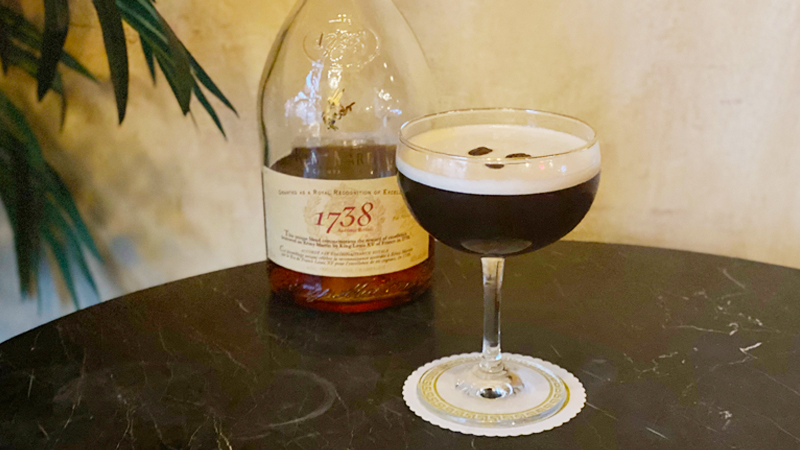Invented by legendary British barman Dick Bradsell in the early 1980s, the Espresso Martini soon became a beloved mainstay of bars worldwide. The original recipe combined a smooth elixir of espresso, coffee liqueur, and sugar to temper the punch of vodka. While Bradsell’s frothy concoction was a worldwide hit, the hallmark of a classic cocktail has always been the ability for bartenders to adapt and modernize the recipe.
In Rémy Martin’s version, vodka is replaced by Rémy Martin’s 1738® Accord Royal Cognac, a celebratory label created to honor King Louis XV. The 1738 Accord Royal Cognac’s blend of Eaux-de-vie, aged in toasted French oak barrels, produces notes of dark chocolate, butterscotch, and baking spices.
In a cocktail featuring espresso and coffee liqueur, the addition of Cognac is a no-brainer. As detailed to VinePair by Martin Hudak, partner at Maybe Sammy in Sydney, Australia, the combination of coffee and Cognac or brandy is one of the oldest drink combinations we know.
“From the steaming Café Brûlot to punches or [the] Café Gloria, these two elements are tied up not only by history but as well by flavor. Both coming from fruits such as coffee cherry and grape, but different varieties and processing practices, will give us different results,” Hudak explains.
Though Cognac and coffee are already a match made in heaven, VinePair sought out bartenders with the expertise to elevate the original recipe of the Rémy Martin Espresso cocktail:
Rémy Espresso Martini
Ingredients:
- 1 ½ ounce Rémy Martin 1738
- 1-ounce espresso
- ½ ounce coffee liqueur
- ½ ounce simple syrup
Instructions:
- Shake.
- Strain twice.
- Serve in a classic coupe or Martini glass.
Many industry pros recommend playing with the variety of coffee used for the espresso, while others suggest variations of syrups, garnishes, and even glassware that could take the cocktail to a new level.
Former barista Nick Pratt, now the assistant general manager and bar manager at Hojoko in Boston, has firsthand knowledge of coffee trends. “In this country, [people] are realizing there’s a lot more to coffee than just something that [pairs] with cream and sugar,” he says noting that consumers have become increasingly more comfortable spending higher amounts of their money on the product.
For the Rémy Espresso, however, Pratt says you don’t need to spend a lot to get a coffee that provides a solid base. Focusing on coffee with chocolate and nutty flavors, which Pratt says would perfectly complement the Accord Royal Cognac, he recommends beans that hail from Mexico or Central and South America.
Building on his own experiments combining Tiki flavors with coffee, Pratt believes that the addition of a spiced syrup would “go really well with the coffee” and help cut the cocktail’s sugary notes. In order to complement the unique flavors found in the Rémy Espresso Martini, Pratt also recommends a small grating of nutmeg as a final flourish.
Bar manager Emily McKenna of Denver’s Queens Eleven also looks to South America for her recipe twist, but emphasized that the correct blend of coffee was key. “Coffee origin is so important when incorporating espresso into cocktails,” she says. For the Rémy Espresso, McKenna suggests Sträva Craft Coffee’s Ethiopian and Colombian blend.
“The Colombian provides great body that allows the coffee to shine through the other ingredients in the cocktail, [while] the Ethiopian gives it the more nuanced floral and fruity flavors that pair perfectly with the Rémy Martin,” McKenna adds.
Steven Nichols, the cocktail curator at Mathews Food & Drink in Jersey City, N.J., recommends La Colombe Coffee Roaster’s Corsica roast for its prominent notes of chocolate and spice. For a truly decadent addition, he suggests including cinnamon simple syrup to round out the drink. According to Nichols, the cinnamon helps to “tie together the coffee, chocolate, and vanilla and put the bow on the perfect dessert cocktail!”
Los Angeles-based bartender and classic cocktail aficionado Lucas Assis also look to enhance the cocktail’s flavors by upgrading to vanilla simple syrup. With the vanilla syrup bringing out the coffee’s “sweet notes,” Assis bumps up the amount of Rémy Martin from 1½ ounces to 2 ounces and finishes the drink with a grated coffee bean.
Laura Newman, the owner of Queen’s Park in Birmingham, Ala., knows a thing or two about Espresso Martinis; they’re one of the bar’s best-selling cocktails of all time. While Newman shakes them up with her own artisan coffee liqueur and the “rich and complex” Royal Cup Coffee espresso, she also places a special emphasis on the cocktail’s presentation.
Noting that the Espresso Martini deserves a vessel with a touch of extravagance, Newman serves them up in gold-rimmed Leopold Coupes sourced from Cocktail Kingdom. According to Newman, the Leopold Coupe is “both beautiful and functional [and] has a great curve, which keeps drinks from splashing out, even when our guests are joining us for a wild weekend night.”
For Newman’s variation on the Espresso Martini, she uses a touch of Pedro Ximénez, a rich and syrupy sweet sherry, along with a dash of saline solution and chocolate bitters to complement the original flavor profiles.


Laura Newman’s Espresso Martini
Ingredients:
- 1 ½ ounce Rémy Martin 1738
- 1-ounce espresso
- ⅜ ounce coffee liqueur
- ¼ ounce Pedro Ximénez sherry
- ¼ ounce vanilla syrup*
- 1 dash saline**
Instructions:
- Combine all ingredients in a shaker tin with ice.
- Shake hard (you want to get a nice foam on top).
- Strain into a coupe.
- Garnish with 3 coffee beans.


